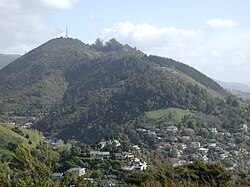|
The Grampians (New Zealand)
The Grampians are a set of prominent hills forming the southeast backdrop of Nelson, New Zealand, reaching 390 metres (1,280 ft) high.[3] Frequented by locals and tourists alike, the Grampians are covered in a myriad of tracks ranging from leisurely strolls to relatively taxing steep inclines. Entry points to this recreational area are from
A television and FM radio transmitter sits atop the hills. The transmitter was commissioned in 1971 by the New Zealand Broadcasting Corporation to broadcast NZBC TV (now TVNZ 1), offering improved coverage to Nelson and Tasman compared to the existing private translators relaying the NZBC TV signal from the Mount Kaukau transmitter in Wellington.[4] Several community and volunteer groups are working towards restoring habitats for native birds on the Grampians by reducing the impact of predators, using pest control methods in conjunction with the Brook Waimarama Sanctuary. Areas of interestThe main track zigzags up to the ridge of the hills, providing access to good views over most of Nelson. A lookout near the top offers views over much of the Nelson region. DemographicsGrampians statistical area, which covers 2.95 km2 (1.14 sq mi),[1] had an estimated population of 2,730 as of June 2024,[2] with a population density of 925 people per km2.
Grampians had a population of 2,412 at the 2018 New Zealand census, an increase of 177 people (7.9%) since the 2013 census, and an increase of 471 people (24.3%) since the 2006 census. There were 885 households, comprising 1,218 males and 1,194 females, giving a sex ratio of 1.02 males per female. The median age was 38.2 years (compared with 37.4 years nationally), with 474 people (19.7%) aged under 15 years, 453 (18.8%) aged 15 to 29, 1,185 (49.1%) aged 30 to 64, and 297 (12.3%) aged 65 or older. Ethnicities were 78.2% European/Pākehā, 15.8% Māori, 3.7% Pasifika, 11.8% Asian, and 2.1% other ethnicities. People may identify with more than one ethnicity. The percentage of people born overseas was 24.1, compared with 27.1% nationally. Although some people chose not to answer the census's question about religious affiliation, 56.5% had no religion, 30.8% were Christian, 1.6% were Hindu, 0.2% were Muslim, 1.5% were Buddhist and 2.1% had other religions. Of those at least 15 years old, 375 (19.3%) people had a bachelor's or higher degree, and 417 (21.5%) people had no formal qualifications. The median income was $26,300, compared with $31,800 nationally. 198 people (10.2%) earned over $70,000 compared to 17.2% nationally. The employment status of those at least 15 was that 927 (47.8%) people were employed full-time, 300 (15.5%) were part-time, and 93 (4.8%) were unemployed.[5] References
|
|||||||||||||||||||||||||||||||||||||||||||||||||||||||||||||||

